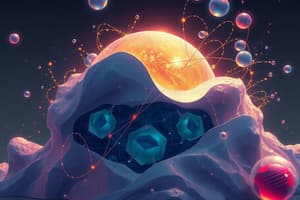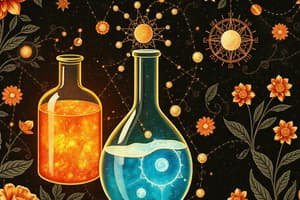Podcast
Questions and Answers
What is the basic unit of matter?
What is the basic unit of matter?
- Element
- Compound
- Atom (correct)
- Molecule
Which state of matter has a definite volume but no definite shape?
Which state of matter has a definite volume but no definite shape?
- Liquid (correct)
- Solid
- Plasma
- Gas
What type of chemical bond is formed by the sharing of electrons between atoms?
What type of chemical bond is formed by the sharing of electrons between atoms?
- Covalent Bond (correct)
- Metallic Bond
- Ionic Bond
- Polar Bond
What are the substances formed as a result of a chemical reaction called?
What are the substances formed as a result of a chemical reaction called?
Which type of reaction involves the exchange of ions between two compounds?
Which type of reaction involves the exchange of ions between two compounds?
What do acids donate in an aqueous solution?
What do acids donate in an aqueous solution?
What is the primary factor affecting the rate of a chemical reaction?
What is the primary factor affecting the rate of a chemical reaction?
Which type of reaction absorbs energy from the surroundings?
Which type of reaction absorbs energy from the surroundings?
Flashcards are hidden until you start studying
Study Notes
Basic Concepts of Chemistry
- Matter: Anything that has mass and occupies space.
- Atoms: Basic unit of matter, made up of protons, neutrons, and electrons.
- Molecules: Two or more atoms bonded together.
States of Matter
- Solid: Definite shape and volume; particles are closely packed.
- Liquid: Definite volume but takes the shape of its container; particles are less tightly packed.
- Gas: No definite shape or volume; particles are far apart and move freely.
Atomic Structure
- Protons: Positive charge, found in the nucleus.
- Neutrons: No charge, also in the nucleus.
- Electrons: Negative charge, orbiting the nucleus in energy levels.
Periodic Table
- Groups: Vertical columns; similar chemical properties.
- Periods: Horizontal rows; increasing atomic number.
- Elements: Pure substances represented by symbols (e.g., H for Hydrogen).
Chemical Bonds
- Ionic Bonds: Formed through the transfer of electrons from one atom to another.
- Covalent Bonds: Formed by the sharing of electrons between atoms.
- Metallic Bonds: Involves a 'sea' of shared electrons among metal atoms.
Chemical Reactions
- Reactants: Substances that undergo change.
- Products: Substances formed from the reaction.
- Types of Reactions:
- Synthesis: Two or more reactants combine to form one product.
- Decomposition: One reactant breaks down into two or more products.
- Single Replacement: One element replaces another in a compound.
- Double Replacement: Exchange of ions between two compounds.
Stoichiometry
- The calculation of reactants and products in chemical reactions.
- Based on the conservation of mass and mole ratios from balanced equations.
Acids and Bases
- Acids: Substances that donate protons (H⁺ ions) in solution; have a pH < 7.
- Bases: Substances that accept protons or donate hydroxide ions (OH⁻); have a pH > 7.
- pH Scale: Measures acidity or alkalinity of a solution, ranging from 0 (most acidic) to 14 (most basic).
Thermodynamics in Chemistry
- Exothermic Reactions: Release energy (heat) to the surroundings.
- Endothermic Reactions: Absorb energy (heat) from the surroundings.
Kinetics
- Study of the rates of chemical reactions.
- Factors affecting reaction rates:
- Concentration of reactants
- Temperature
- Surface area
- Presence of catalysts
Chemical Equilibrium
- The state in which the forward and reverse reactions occur at the same rate.
- The concentrations of reactants and products remain constant.
Organic Chemistry
- Study of carbon-containing compounds.
- Key functional groups include:
- Hydroxyl (-OH)
- Carboxyl (-COOH)
- Amino (-NH₂)
Inorganic Chemistry
- Study of inorganic compounds, often including metals and minerals.
- Notable categories:
- Salts
- Oxides
- Coordination compounds
Basic Concepts of Chemistry
- Matter is defined as anything that possesses mass and occupies space.
- Atoms, the fundamental units of matter, consist of protons (positive charge), neutrons (no charge), and electrons (negative charge).
- Molecules are formed when two or more atoms bond together.
States of Matter
- Solids maintain a definite shape and volume, with particles closely packed together.
- Liquids have a definite volume but adapt to the shape of their container, featuring more loosely packed particles.
- Gases lack both definite shape and volume, with particles that are far apart and move freely.
Atomic Structure
- Protons and neutrons reside in the nucleus of an atom.
- Electrons orbit the nucleus in specified energy levels, contributing to the atom's charge balance.
Periodic Table
- Groups, the vertical columns on the periodic table, contain elements with similar chemical properties.
- Periods are horizontal rows indicating an increase in atomic number from left to right.
- Each element is a pure substance represented by a unique symbol, such as H for Hydrogen.
Chemical Bonds
- Ionic bonds form through the transfer of electrons, resulting in charged ions.
- Covalent bonds arise from the sharing of electrons between atoms.
- Metallic bonds involve a collective sharing of electrons in a 'sea' among metal atoms.
Chemical Reactions
- Reactants are substances involved in chemical transformations, while products are the new substances created as a result.
- Major types of reactions include:
- Synthesis: Multiple reactants combine into one product.
- Decomposition: A single reactant breaks down into several products.
- Single Replacement: An element in a compound is replaced by another element.
- Double Replacement: Two compounds exchange ions.
Stoichiometry
- Stoichiometry involves calculating the amounts of reactants and products in chemical reactions, based on balanced equations and conservation of mass.
Acids and Bases
- Acids are substances that donate protons (H⁺ ions) in solution, characterized by a pH less than 7.
- Bases accept protons or donate hydroxide ions (OH⁻), with a pH greater than 7.
- The pH scale quantifies the acidity or basicity of solutions, with a range from 0 (most acidic) to 14 (most basic).
Thermodynamics in Chemistry
- Exothermic reactions release heat to the environment, resulting in temperature increases in surrounding areas.
- Endothermic reactions require heat from the environment, causing surrounding temperature decreases.
Kinetics
- Kinetics is the study of the rates of chemical reactions, influenced by factors such as:
- Concentration of reactants
- Temperature
- Surface area of reactants
- Presence of catalysts that speed up reactions
Chemical Equilibrium
- Chemical equilibrium occurs when the forward and reverse reactions happen at equal rates, leading to stable concentrations of reactants and products.
Organic Chemistry
- Organic chemistry focuses on carbon-containing compounds and essential functional groups, including:
- Hydroxyl (-OH)
- Carboxyl (-COOH)
- Amino (-NH₂)
Inorganic Chemistry
- Inorganic chemistry studies compounds that generally do not contain carbon, including metals and minerals.
- Key categories in inorganic chemistry comprise salts, oxides, and coordination compounds.
Studying That Suits You
Use AI to generate personalized quizzes and flashcards to suit your learning preferences.




